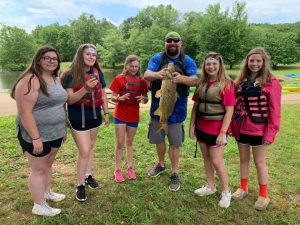
This group of 4-H youth, volunteers, and agent are enjoying the wonders of their outdoor environment. *This picture was taken prior to our challenges with Covid-19 and we encourage people to practice social distancing and wear a mask when around others.*
For many people, 4-H exists in the agriculture science and livestock husbandry realm of youth development. 4-H members showing livestock and entering exhibits at the county fair come to our minds when we see the ol’ green and white clover emblem. That is still very much a part of what we are today. However, 4-H has expanded and remodeled throughout the years. Now more than ever we are more diversified in our educational efforts. 4-H truly has something for everyone. Robotics, STEM, citizenship, meat science, consumer decision making, environmental sciences, and many more keep us relative and our mission of “learn by doing” separates us from others.
Today, I want to focus on why 4-H is “making the best better” in environmental sciences. 4-H professionals must provide youth with opportunities to apply what they have learned from their involvement in 4-H programs. When youth participate in educational programs in environmental science, who do you think wins? The environment we live in! Environmental science can be defined as a branch of biology focused on the study of the relationships of the natural world and the relationships between organisms and their environments. As you can see, this is a very broad topic. 4-H offers educational opportunities in wildlife and fisheries ecology, forestry, marine sciences and many more natural resource topics. Studies show that 4-H members go back into their communities and apply what they learn. This is a direct result of life skill development. In addition, these natural resource programs allow youth and adult volunteers to see the complexity of available natural resources and the connections to other fields of discovery like engineering.
Let’s look at how 4-H works in a nutshell. The child and/or adult attends 4-H Marine Camp where they participate in a fun hands on activity on plastics in water. The participant then goes back to the community with a greater understanding of use and recycling. He or she then shares with others about the experience. I have a particular interest in wildlife management. I enjoy teaching children and adults about species identification and habitat. Personally, I have seen the spark in the eyes of a 4-H member when learning about animals. Children learning the importance of environmental stewardship start with a relationship built by participating in a natural resource activity. 4-H can make that bridge between youth and mentor! Take a loved one on a hike or grab a pole and go fishing, better yet, reach out to your local county extension office and ask how you and/or your youth can be involved in 4-H Environmental Science.
Special thanks to Ronnie Cowan, UF/IFAS Okaloosa County 4-H Agent and County Extension Director, for providing this article and picture(s).
- Why Crafts are Important to 4-H Project Work - August 27, 2024
- Teens As Teachers: Using The Peer Teaching Model in 4-H - May 19, 2023
- Life Skills Focused on Teens - April 6, 2023
